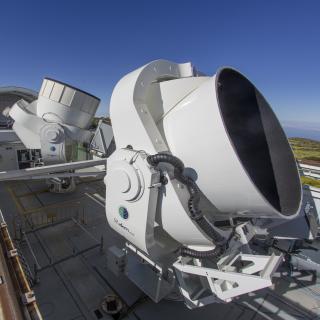Bibcode
Fernández-Torreiro, M.; Rubiño-Martín, J. A.; López-Caraballo, C. H.; Génova-Santos, R. T.; Peel, M. W.; Guidi, F.; Harper, S. E.; Artal, E.; Ashdown, M.; Barreiro, R. B.; Casas, F. J.; de la Hoz, E.; Herranz, D.; Hoyland, R.; Lasenby, A.; Martínez-Gonzalez, E.; Piccirillo, L.; Poidevin, F.; Rebolo, R.; Ruiz-Granados, B.; Tramonte, D.; Vansyngel, F.; Vielva, P.; Watson, R. A.
Bibliographical reference
Monthly Notices of the Royal Astronomical Society
Advertised on:
11
2023
Citations
8
Refereed citations
6
Description
Anomalous microwave emission (AME) is an important emission component between 10 and 60 GHz that is not yet fully understood. It seems to be ubiquitous in our Galaxy and is observed at a broad range of angular scales. Here we use the new QUIJOTE-MFI wide survey data at 11, 13, 17, and 19 GHz to constrain the AME in the Galactic plane (|b| < 10°) on degree scales. We built the spectral energy distribution between 0.408 and 3000 GHz for each of the 5309 0.9° pixels in the Galactic plane, and fitted a parametric model by considering five emission components: synchrotron, free-free, AME, thermal dust and CMB anisotropies. We show that not including QUIJOTE-MFI data points leads to the underestimation (up to 50 per cent) of the AME signal in favour of free-free emission. The parameters describing these components are then intercompared, looking for relations that help to understand AME physical processes. We find median values for the AME width, WAME, and for its peak frequency, νAME, respectively of $0.560^{+0.059}_{-0.050}$ and $20.7^{+2.0}_{-1.9}$ GHz, slightly in tension with current theoretical models. We find spatial variations throughout the Galactic plane for νAME, but only with reduced statistical significance. We report correlations of AME parameters with certain ISM properties, such as that between the AME emissivity (which shows variations with the Galactic longitude) and the interstellar radiation field, and that between the AME peak frequency and dust temperature. Finally, we discuss the implications of our results on the possible molecules responsible for AME.
Related projects

QUIJOTE CMB Experiment (Q-U-I JOint TEnerife CMB Experiment)
QUIJOTE es un programa de dos telescopios y su batería de instrumentos, instalados en el Observatorio del Teide, dedicados fundamentalmente a la caracterización de la polarización del Fondo Cósmico de Microondas, en el rango de frecuencias de 10-42 GHz.
José Alberto
Rubiño Martín

Anisotropy of the Cosmic Microwave Background
The general goal of this project is to determine and characterize the spatial and spectral variations in the temperature and polarisation of the Cosmic Microwave Background in angular scales from several arcminutes to several degrees. The primordial matter density fluctuations which originated the structure in the matter distribution of the present
Rafael
Rebolo López